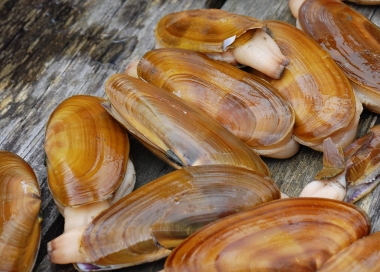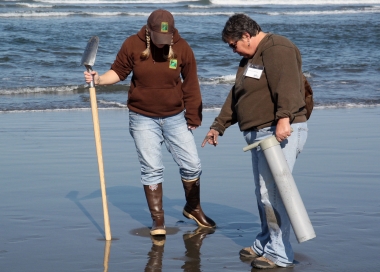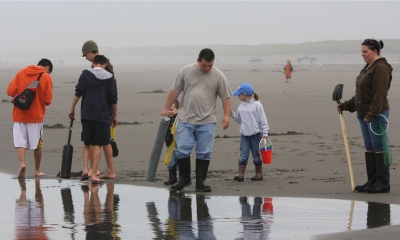
Start clamming
Digging for razor and bay clams is fun, easy and tasty.

Make sure it’s safe to clam
Check the shellfish hotline – When there are high levels of domoic acid or other biotoxins in ocean waters, all or part of the Oregon coast may be closed to clam harvesting for public safety. Before leaving for a crabbing (or clamming) trip, always check the Oregon Department of Agriculture website or call the ODA hotline at 1-800-448-2474 for any current closures.
Shellfish and biotoxins – Learn more about the effect of biotoxins on clams and clam digging.
Keep an eye on conditions – The best clamming is during the lowest tides, but even then, ocean swells can be unpredictable. The old saw about “never turn your back on the ocean” has a lot of truth to it.
Decide what to dig for
Razor clams are large, meaty, sweet-tasting clams that are prized by clam diggers. They have a relatively restricted range – 90 percent of all razor clams are harvested from 18 miles of beach in Clatsop County. These same beaches are closed to razor clamming from July 15 to Sept. 30 to protect the young clams.
Visit the clam species page for more in depth information about razor clams.
“Bay clams” is a catch-all term that includes pretty much everything that isn’t a razor clam, including gaper, butter, littleneck clams, as well as cockles. Softshell and purple varnish clams often often grouped with bay clams, but they have their own bag limits (see Check the regulations below). Bay clams are widely distributed up and down the coast, and are available for harvest throughout the summer.
Visit the clam species page for more in depth information about each bay clam species.
Get some gear
It doesn’t take much gear to go clamming.
Tools to dig clams
- A clam shovel has a narrow, angled blade to dig straight down in the sand.
- A clam gun is a long tube of plastic or stainless steel about 4-5 inches in diameter and a couple of feet tall. Push the tube into the sand around the clam show, cover the air hole at the top of the gun and pull (using your legs!). Out comes a core of sand with the clam.
- A shrimp gun is great to help take the work out of deeper clams, by using the water in the hole to soften the mud or sand.
- A four-tine garden rake is perfect for raking cockles. Clammers can find these hard-shell clams near, or even on, the surface by raking through the soft sand until they hit a hard clam.
Something to hold clams
- Some people prefer a mesh bag to put their clams in, but a bucket will do.
- Each person clamming must have their own bucket or bag to keep their clams in.
Rubber boots, hip boots or waders
- Clamming can be a wet, muddy, sandy activity. A good pair of rubber boots will help keep you dry.
- Waders will keep you even drier and cleaner.
- Or, during the warm summer months you can have fun getting wet, muddy and sandy.
Learn to clam
How to bay clam – Tips and how-to videos for harvesting cockles, and gaper, butter, littleneck, softshell and purple varnish clams.
Bay clamming basics – Watch this three-minute video to learn about harvesting the different bay clams on the Oregon coast.
How to razor clam – Here’s what you’ll need to know to harvest these delicious bivalves.
How to clean a razor clam -- A three-minute video showing how easy it is to clean a razor clam.
Where to clam
Where to bay clam in Oregon – Almost all bays, beaches and estuaries on the Oregon coast have bay clams. This article links to maps of 11 popular clamming areas.
Razor clams – Most razor clams are harvested from the beaches in Clatsop and nearby counties on the north coast. There are more ephemeral populations elsewhere in the central and southern Oregon coasts.
When to clam
Clamming is a year-round opportunity on the Oregon coast, but your success will be influenced by the season, the tide and a conservation closure.
Clamming through the seasons – Here’s a look at clamming throughout the year.
Tide chart – The best clamming will be during the lowest tides – negative tides are the best. The lower the tide, the more sand there is to dig in.
Razor clam conservation closure – The razor clam beaches in Clatsop and nearby counties are closed to razor clamming from July 15 – Sept. 30 to protect young clams.
Buy a license
Buy a shellfish license -- Everyone 12 years or older will need a shellfish license to clam or crab in Oregon. No other tags, permits, validations, etc. are required.
You can buy a license online or at an ODFW license vendor. If you’re buying your license online, you can print out a hard copy on your home computer, or download your license to your smart phone using the MyODFW app.
If you prefer to buy a license in-person, you can go to one of ODFW’s license vendors. This includes many Bi-Mart and Fred Meyer stores as well as several small independent retailers.
Check the regulations
Check the regulations – Shellfish regulations are their own section in the Oregon Sport Fishing Regulations. The regulations describe legal harvest methods and how many clams of each species you can keep – from 15 per day for razor clams to 72 per day for purple varnish clams.
You can check the regulations online, or get a printed booklet at an ODFW license vendor, or call your local ODFW office and we’ll send you one.
Clean your catch
Soak your clams in fresh seawater – Before cleaning your clams, soak them in a bucket of fresh seawater for 30 minutes or so. This will cause the clams to expel any sand they’ve ingested, and keep the grit out of your chowder.
Share your adventure
Don’t forget the kids – Why wouldn’t you bring the kids to enjoy the 360-mile-long sandbox defining the Oregon coast. Clamming involves getting muddy, sandy and wet, and finding sea creatures – what’s not to love?
However, clamming also involves water and potentially high waves. So, even when swells seem small, keep an eye on both the ocean and on the kids.
Take a photo -- For those that can’t go clamming with you, a photo is the next best thing. You also can submit your photos to ODFW for use on our website, in brochures and on signs, and your photo could be shared with thousands of your closest friends.
Post to ODFW social media – We love it when clammers share their experiences (and not just their trophies) on Facebook, Instagram or Twitter.
Go clamming!
By now you’ve probably already learned everything you can about clamming from the internet. The best way to learn more is to get your feet wet and go clamming. You’ll learn more on your first clamming trip than anywhere else.
Also, keep an eye on other clammers and learn from them. There aren’t many secrets on the clamming beach and you can pick up a lot just watching others.
Still wanting to learn more about shellfishing, fishing or hunting in Oregon? We’ve got all kinds of articles and tip sheets for all kinds of activities. Just use the search button on MyODFW.com if you’re looking for something specific. If you’d rather browse to see what’s available, go to the articles page and use the filter feature to narrow your search.
Have fun and stay safe.
Check out our other Start… articles
All photos by ODFW.




